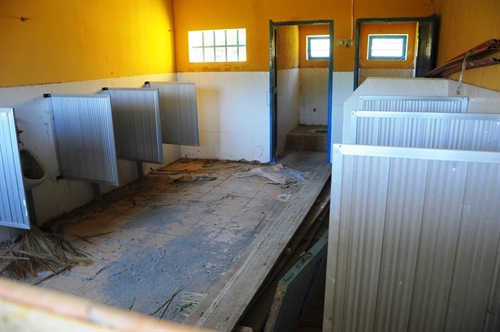 Op-Ed
Op-Ed

As children across the country return to school after the summer break, a little spoken about yet very real and imperative issue has come under the spotlight: unhygienic school toilets.
 |
| A degraded toilet in Phước Cát 2 elementary school in Lâm Đồng Province. Even in big cities like Hà Nội, HCM City, Đà Nẵng and Cần Thơ, many schools do not have adequate toilets for students. Photo: tuoitre.vn |
Vũ Thu Hà
As children across the country return to school after the summer break, a little spoken about yet very real and imperative issue has come under the spotlight: unhygienic school toilets.
Deputy Prime Minister Vũ Đức Đam made headlines two weeks ago when he raised the issue at a government meeting on education, telling participants that during his recent field trips to some schools in Hà Nội and neighbouring provinces, he found out that “at many schools, while toilets for headmasters are very clean, those for students are awfully dirty.”
“I can even smell the stinking odour right at the entrance gate of some schools,” he said.
What a sad piece of news to hear just as the new school year is approaching. What makes me feel worse is that the issue is nothing new. It has persisted this way for too many years.
Some 20 years ago, the same problem bothered my generation. Back then I was a student at a junior high school in central Hoàn Kiếm District of Hà Nội. Contrary to its fame as one of the best schools in the district, its toilet was without a roof and smelly all the time, especially during summer. Unexpectedly, I am still haunted by the “nightmare” of having to hold my breath each and every time I used the toilet back then.
I can’t help but wonder why, after such a long time in which Việt Nam has seen remarkable achievements in economic and social development, the very basic necessity of having a proper toilet is still a dream for many of our children, often dubbed “the country’s future”.
A UNICEF survey has shown only 11.7 per cent of school toilets in Việt Nam met safety standards. Even in big cities like Hà Nội, HCM City, Đà Nẵng and Cần Thơ, many schools do not have adequate toilets. The situation is worse in rural areas, where 27 per cent of children have to practice open defecation or urination.
To a certain extent, I can understand the difficulties of many schools in impoverished rural areas, where just having classrooms is considered a success. But I cannot digest the fact that the situation is also alarming in localities where trillions of đồng have been spent on imposing local authority offices, monuments, or lavish but not-so-meaningful ceremonies, as you may know.
But perhaps it is not that the education sector lacks money. We have seen the Ministry of Education asking for VNĐ778 billion (US$34.9 million) from the Government’s budget to renew school textbooks alone. We have seen schools being rebuilt and renovated one after another. On the long list of extra-fees that parents have to pay at the beginning of each semester (which make many lament) there are the so-called “sanitary fee” and “school-building fee”.
That says it all. What is lacking here is the due care and responsibility of educational leaders for their students’ health and benefits. Or perhaps it is this simple: they just think a toilet is not a big deal.
Wait! Isn’t securing a comfortable and quality toilet one of the first things we think of when building our own house? Isn’t access to a hygienic toilet a basic human right that we all deserve?
Doctors have pointed out that dirty restrooms are a source of gastrointestinal and respiratory diseases like diarrhoea and pneumonia. It does not only affect children; the disease could be carried home by them and then spread illness to their families. Unhygienic toilets also scare children, and trying to avoid using them can cause children constipation and urinary infections.
In July 2014, two children in HCM City died from digestion-related diseases caused by unclean school toilets. Four months later, a similar cause forced 220 students in an elementary school in the City’s District 12 to be absent from school.
A lack of toilets also contributes to an increase in drop-out rates, as shown by the case of India, which suffers from an even more serious situation.
And last but not least, it is the students’ feeling of being disrespected and uncared for that matters. Over the past years, many reforms have been carried out in the country’s education system with the aim of “inverting the traditional teacher-centred to student-centred teaching and learning process.” That means allowing students to play a bigger role in class, and to have their voices heard and respected more.
But only by looking at the stark contrast between the school headmasters’ toilets and those of the students as pointed out by Deputy PM Đam’s comment, it is easy to tell that in many schools the “centre” has not been inverted much. Teachers are still prioritised and students’ basic needs remain uncared for.
Anyway, a piece of good news came last week when the Chairman of Hà Nội People’s Committee Nguyễn Đức Chung pledged that in the next two years, the city would renovate toilets in 2,600 schools in the city with tailor-made facilities that the city has ordered from foreign producers.
It is encouraging that the issue is starting to be taken seriously by the city’s leaders even though it is late in the day. Hopefully other provinces and cities will follow suit, so that we will have a sort of a nationwide campaign, something similar to the famous ‘Clean India’ campaign initiated by Indian Prime Minister Narendra Modi in his country.
Only then can I let go of the worry that my son, my nephews, and many other children will grow up being haunted by the same “nightmare” as mine.
After all, education is not just about knowledge, books, or exams. It is also about the excitement and comfort one can enjoy in a healthy environment that makes him or her grow up physically and mentally strong. Don’t let a dirty toilet spoil it! – VNS




